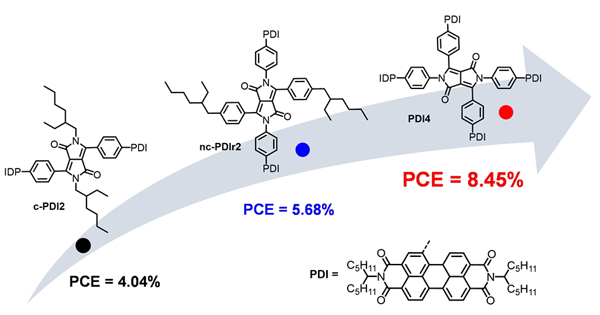摘要/Abstract

苝二酰亚胺类小分子由于其固有的强分子聚集特性,导致活性层形貌难于调控,器件效率相对于近年来报道的受体-给体-受体型稠环小分子受体一直处于劣势.针对这一关键问题,我们设计并合成了三个以吡咯并吡咯二酮为中心核的双臂型和四臂型苝二酰亚胺类小分子受体.其中,c-PDI2和nc-PDI2两个双臂型分子分别将两个苝二酰亚胺臂置于吡咯并吡咯二酮核心骨架的碳取代位和氮取代位;四臂型PDI4是将四个苝二酰亚胺臂置于吡咯并吡咯二酮核心骨架的四个取代位.通过对三个受体小分子的光谱吸收、能级水平、薄膜形貌以及光伏性能的详细研究,发现三个受体小分子都拥有扭曲的分子结构并由此带来无定形薄膜形貌,表明其分子聚集趋势得到了有效的抑制.相对于双臂型受体分子,四臂型PDI4具有更强的光吸收能力和电子传输性能,从而获得了8.45%的最高光电转换效率,是c-PDI2器件效率的2倍和nc-PDI2器件效率的1.5倍.
关键词: 聚合物太阳能电池, 非富勒烯受体, 苝二酰亚胺, 三维构型, 高效率
Polymer solar cells (PSCs) experienced a leap forward recently due to the development of non-fullerene acceptors. These novel acceptor materials possess improved photon absorption ability as well as readily tunable band structures compared to the conventional fullerenes. Perylene diimide (PDI) derivatives were among the first investigated non-fullerene acceptors for PSCs. PDI is widely adopted as building blocks for acceptor materials for its high photon absorption and electron transporting abilities, suitable and tunable energy levels, ease of synthesis and excellent photon stability. However, PDI derivatives are well known for their aggregation tendency to result in poor blend morphology, which leads to lower device efficiency than the acceptor-donor-acceptor type fused ring small molecular acceptors. To address this issue, we designed and synthesized three PDI based small molecular acceptors with a diketopyrrolopyrrole (DPP) core. The c-PDI2 and nc-PDI2 were two-PDI-armed molecules with PDI substituents attached on the carbon or nitrogen atoms of the DPP skeleton, respectively, while PDI4 was a four-PDI-armed molecule. The PDI units were predicted by molecular simulations to be positioned in altered planes forming the twisted 3D structures, which would reduce the intermolecular aggregation. Based on optical absorption, energy level, blend morphology and photovoltaic performance studies, all three molecules were found with amorphous morphology, which indicated that the aggregation tendency was efficiently suppressed. Among the three molecules, the four-armed PDI4 displayed the flatter structure with broadened electron delocalization which led to significantly increased extinction coefficient and electron transport mobility. The faster electron transport of PDI4 assured the balanced charge transport which yielded into a higher field factor (FF) over 65% in contrast to the two-armed molecules with FFs under 55% in the respective PSC devices. With additional aids from the increased photon absorption, PSCs containing PDI4 also generated substantially higher photocurrent. These improvements afforded the highest power conversion efficiency (PCE) as high as 8.45% among the three PDI derivatives, which was twice and 1.5 times of those of c-PDI2 and nc-PDI2, respectively. In comparison between the two two-armed PDI derivatives, the nitrogen-position-substituted nc-PDI2 delivered higher device performances than the carbon-position-substituted c-PDI2, also thanked to its flatter molecular arrangement and broader intra- and intermolecular electron delocalization. In our study, we successfully prevented aggregation of PDI derivatives by constructing 3D molecular structures with multiple PDI units. The numbers and substituting positions of PDIs on the DPP core were also investigated in detail, which provided valuable insights for designing of high performance PDI derivatives for PSCs.
Key words: Polymer solar cells, non-fullerene acceptor, perylene diimide, three-dimensional, structure, high efficiency
PDF全文下载地址:
点我下载PDF
